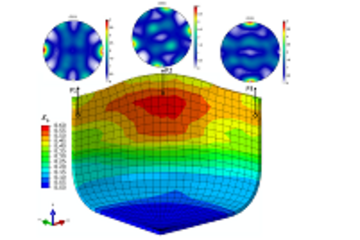All genres
81.
Journal Article
Breakdown of ultrathin anodic valve metal oxide films in metal-insulator-metal-contacts compared with metal-insulator-electrolyte contacts. Thin Solid Films 414, pp. 296 - 303 (2002)
82.
Journal Article
Trapping of transient processes in aluminium oxide thin films in a voltage pulse experiment. Electrochemistry Communications 4, pp. 1 - 4 (2002)
83.
Journal Article
In-situ SKP Investigation and ToF-SIMS Analysis of Filiform Corrosion on Aluminium Alloy 2024-T3. Proceed. Japan Soc. CoRR. Engineer. Mater. Environments 48, pp. 61 - 69 (2001)
84.
Journal Article
The voltage-time behaviour for porous anodizing of aluminium in a fluoride-containing oxalic acid electrolyte. Electrochem. Commun. 3, pp. 299 - 305 (2001)
85.
Journal Article
Cathodic Decomposition and Anodic Dissolution and Changes in Surface Morphology of n-type InP in HCl. J. Electrochem. Soc. 148, pp. B400 - B404 (2001)
86.
Journal Article
Formation and corrosion of InP/In contacts in hydrochloric acid. Electrochim. Acta 45, pp. 4673 - 4682 (2000)
87.
Journal Article
Cathodic Decomposition and Changes in Surface Morphology of InP in HCl. Electrochem. Soc. Proc. PV 00-25, pp. 576 - 585 (2000)
88.
Journal Article
Aluminium Oxide Tunnel Junctions: Influence of Preparation Technique, Sample Geometry and Oxide Thickness. Thin Solid Films 342, pp. 282 - 290 (1999)
89.
Journal Article
An agar-based silver|silver chloride reference electrode for use in micro-electrochemistry. (1999)
90.
Journal Article
Localised Investigation of Coarse Grain Gold with the Scanning Droplet Cell and by the Laue Method. Electrochim. Acta 44, pp. 3769 - 3777 (1999)
91.
Journal Article
The Scanning Droplet Cell and its Application to Structured Nanometer Oxide Films on Aluminium. Electrochimica Acta 42, pp. 3327 - 3333 (1997)
92.
Journal Article
Leitfähigkeit Dünner Anodischer Oxidschichten: Trennung Elektronischer und Ionischer Anteile. (1996)
93.
Journal Article
Ultradünne Aluminiumoxidschichten: Untersuchung elektronischer und ionischer Transportprozesse. Metalloberfläche 50, pp. 19 - 22 (1996)
94.
Journal Article
Ultradünne Aluminiumoxidschichten: Untersuchung elektronischer und ionischer Transportprozesse. Metalloberfläche 50, pp. 19 - 22 (1996)
95.
Journal Article
Initial Stages of Cathodic Breakdown of Thin Anodic Aluminium Oxide Films. Electrochim. Acta 40, pp. 433 - 437 (1995)
96.
Journal Article
Preparation and Properties of Ultra Thin Anodic Valve Metal Oxide Films. Materials Science Forum 185-188, pp. 581 - 590 (1995)
97.
Journal Article
On the Mechanism of Ion Transport in Thin (1-100 nm) Oxide Films on Aluminum and Tantalum. Bulletin of the Chemists and Technologists of Macedonia 13, pp. 49 - 54 (1994)
98.
Book
Passive/active transistions in cyclic corrosion tests. Office for Official Publications of the European Communities, Luxembourg, Luxembourg (2007)
99.
Book
Elektronische und ionische Transportprozesse in ultradünnen Ventilmetalloxidschichten. Shaker Verlag, Aachen, Germany (1997)
100.
Book Chapter
Frontcover und Kalenderblatt der Woche. In: (2007)











